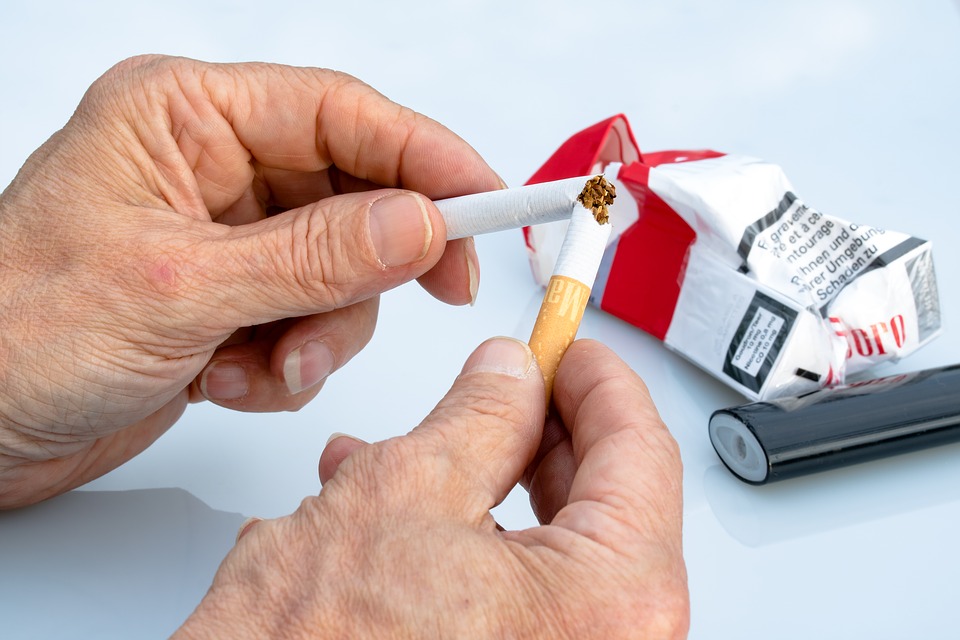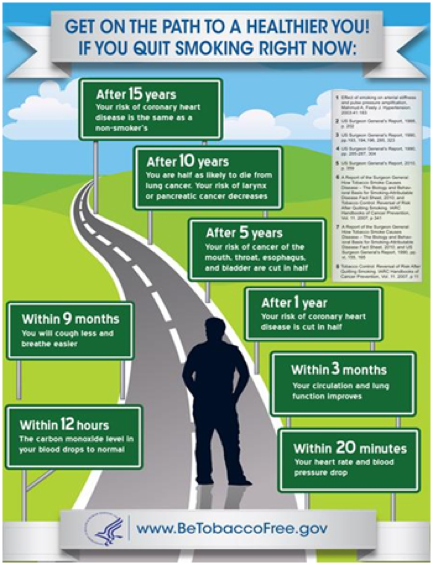
Wanted: Quitters!
Deborah Hendren, Substance Use Prevention Manager, CSPAC
Are you ready to be a quitter that wins? That’s what the Poe Center for Health Education hopes!
Why wait for New Year’s Eve to make a positive resolution? Thursday, November 16 marks the American Cancer Society’s (ACS) Great American Smokeout, an event which encourages smokers to use the date to make a plan to quit. Americans have come a long way; as recently as 1965, more than 40% of adults smoked. While we’ve cut that rate by more than half, the ACS says that nearly one in every five American adults still smokes. Given the damaging effects that smoking has on your body and on the people around you, isn’t smoking a habit you should give up?
According to the Centers for Disease Control and Prevention (CDC), tobacco use is the leading cause of preventable disease, disability, and death in North Carolina. Of the top four leading causes of death in North Carolina (cancer, heart disease, chronic lower respiratory disease, and stroke), all are directly linked to tobacco use.
Additionally, secondhand smoke can be very damaging for children and adults alike. With minimal exposure, it can cause ear infections, respiratory problems, sudden infant death syndrome (SIDS), heart disease, and lung cancer. Those are some scary facts.
The good news is that every minute you don’t smoke helps improve your health. Learn more about the many energizing, life-prolonging benefits your body gets from quitting – you’ll be surprised by how fast recovery kicks in.
Easier said than done, though, as smokers who have tried to quit know too well. It often takes many tries to kick the habit for good. Each year, more than one-third of all smokers try to quit, but fewer than 10 percent succeed.
More good news: if you track smokers over their lifetime, more than half ultimately win the battle. The pathway to success is different for everyone. Quitting isn’t easy, but it’s easier when you have support. Take the “Do You Need Help Quitting?” Quiz to determine your level of nicotine addiction as well as the kind of personal cessation plan you’ll need.
- Quit for a Day
If you can give up cigarettes for 24 hours, you double your chance for permanent success. Within just 24 hours, the carbon monoxide—which hinders blood from bringing oxygen to your cells, tissues, and organs—will be removed from your body, and the mucus and smoking debris will start to clear from your lungs, making breathing easier. - Get the Facts, Get Motivated
Cigarettes and cigarette smoke contain in excess of 7,000 chemicals, including more than 70 known to cause cancer. Understanding how the addictive chemicals impact your health and learning how the body can begin to repair itself after quitting, can serve as a strong motivator. It helps to have a genuine reason to change a behavior in order to be successful long-term. For example, quitting for your family so that you are around to enjoy your kids and grandkids is a powerful one. You need to want it and believe you can do it. - Make a Plan
Talk to your healthcare provider about strategies to quit, such as cold turkey versus over the counter and prescription medication options. Research shows that making a plan and building a support system of family, friends, and professionals improves the chances that you will quit successfully and beat nicotine addiction. - Eliminate Temptations
Remove all ashtrays, lighters, matches, and cigarettes from the house because just seeing them can make you want to smoke. Eating sugarless hard candy or chewing crunchy vegetables helps keep your mouth busy, and the “burning” sensation of cinnamon candy mimics the feeling of smoking and kills the craving. Drinking a lot of water may keep you feeling full. Walking 30 minutes more per day, and reducing your calories modestly prevents you from gaining weight. - Use Available Resources
Take advantage of local resources (covered by Medicaid and many insurance plans) such as the Quitline NC at www.Quitlinenc.com or at 1-800-QUIT-NOW. The Quitline NC provides free cessation services to any North Carolina resident who needs help quitting tobacco use. Quit Coaching is available in different forms, which can be used separately or together, to help any tobacco user give up tobacco.
Be a winner. Quit.
Resources:
- A Day for Quitters: Great American Smokeout. University of Rochester Medical Center. Retrieved on 11.7.17.
- Chronic Disease and Injury Section. NC Health and Human Services. Retrieved 11.7.17.
- Dr. Hays. Fall – A Time for Fresh Starts. Ex-Commmunity. Retrieved 11.7.17.
- How to Quit. Center for Disease Control and Prevention. Retrieved 11.7.17.
- www.Quitlinenc.com
_______________________________________________________________
Featured Poe Program
Interested in bringing this topic to your school or organizations? The Poe Center’s Substance Use Prevention curriculum offers programs for 3rd-12th grades and adults. Book a program on line or call 919-231-4006.
It’s Up 2 U!
Grade Level: 3rd – 5th
Program Length: 45 minutes
Students learn about the “Gateway Drugs” and their effects on the body in a fun and engaging session. Interactive activities and a short movie illustrate key concepts, as well as alternatives to drug use and abuse. This important information will help keep children on the right track!
_______________________________________________________________
For the Classroom: What in the Tar?!?
Take this topic back to your students with this educational activity.
Objective: To demonstrate the amount of tar that can accumulate from one or more cigarettes.
Tar is a sticky substance found on tobacco leaves. Tar coats the lungs and air sacs in smokers, preventing them from getting enough oxygen. Tar paralyzes the cilia in a smoker’s windpipe so that dust particles and pollen are not swept out of the air passages. Tar contains more than 40 cancer-causing chemicals. Organs affected by these poisons include the mouth, vocal chords, throat, and lungs, as well as the kidneys, bladder, and uterus and ovaries (in women).
Supplies:
- Filterless cigarettes and matches
- Cotton balls
- “Smoking Machine”
- Turkey baster or empty ketchup bottle
- Large syringe procedure
Activity:
- Stuff cotton balls into the end of the smoking machine.
- Tape an unfiltered cigarette onto the end of the smoking machine.
- Light the cigarette and draw the smoke back through the cotton balls by pulling back on the syringe or by squeezing the bottle or baster.
- Examine the tar accumulation by looking, smelling, and touching.
Key Points:
- Not all of the tar was caught.
- Smell the inside of the smoking machine to see what a smoker’s breath smells like.
- The accumulation was from only one or two cigarettes. Imagine what the tar accumulation would be from a whole pack of cigarettes.
Additional Great American Smokeout information and teacher activities:
- The Great American Smokeout Anti-Smoking Activities. Education World.
- Smoking, Lesson Plan Library. Discovery Education.

